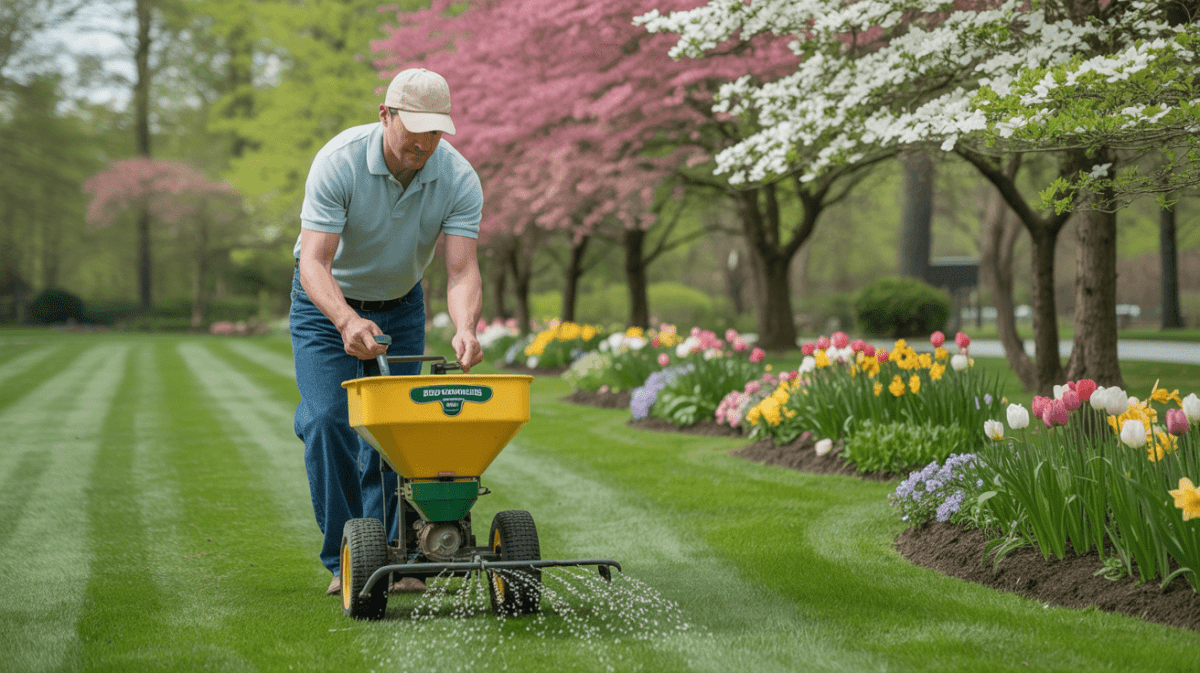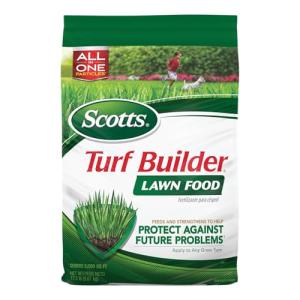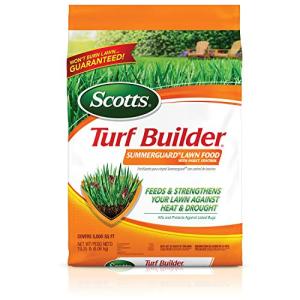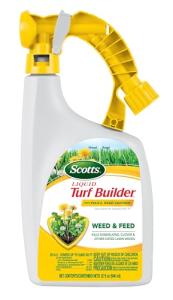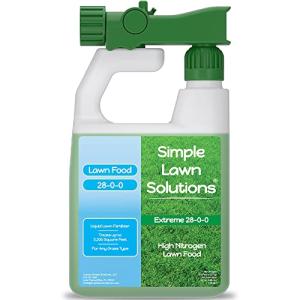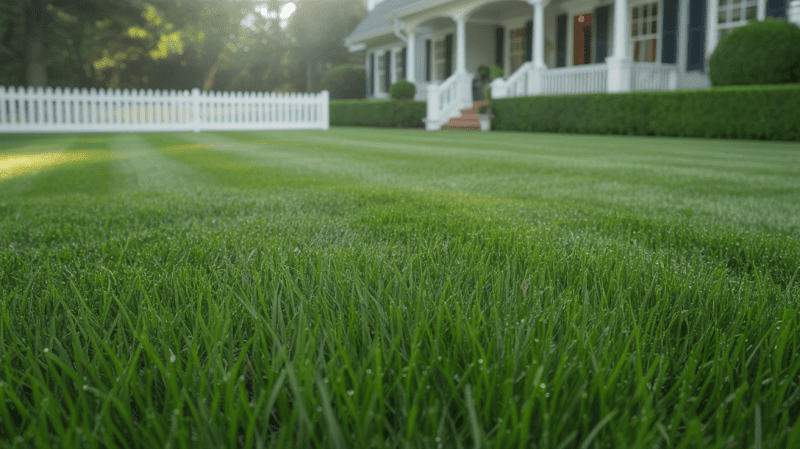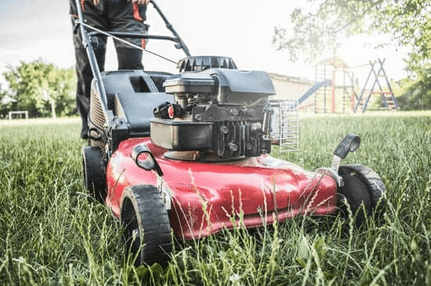Best Time of the Year to Fertilize for Maximum Growth:

Give your lawn a smarter plan this fall, instead of guessing by calendar dates, match fertilizer applications to when your grass is actively growing. That means monitoring soil and air temperatures and following a simple routine during active seasons.
Cool-season grass responds when soil reaches about 55°F and day temps sit in the 60s. Warm-season grass kicks in near 65°F with daytime highs in the 70s. Aim for roughly every 6–8 weeks while growth is happening.
Practical schedules help: fall feedings in northern lawns strengthen roots before winter, while southern lawns should avoid late-fall nitrogen near the first hard frost. Pick lighter formulas during early shoots and stronger, root-building mixes before dormancy for balanced color and resilience.
Key Takeaways
- Use soil temperature (≈55°F cool-season, ≈65°F warm-season) as your cue.
- Apply fertilizer every 6–8 weeks during active growth windows.
- Fall feedings help root depth and spring green lawn performance.
- A simple holiday schedule can help maintain consistent care without added stress.
- Aim for steady, season‑aligned applications rather than one heavy push.
How this How-To Guide Helps You Time Fertilization for a Greener Lawn
A four-times-per-year plan gives lawns steady support for heat, cold, drought, and wear. It sets a simple rhythm across the year so you can match applications to active growth and protect roots when stress hits.
What you’ll get here is practical guidance on fertilization timing by season and region. Early spring notes cover crabgrass prevention in northern yards, while southern guidance explains when a weed-and-feed or insect option makes sense. You’ll learn how to pick a fertilizer and which nutrients matter for thicker, greener growth.
Many brands now offer subscription deliveries based on ZIP code and grass type. A short “holiday schedule” is a user-friendly way to stay on track without guesswork.
- Simple steps that translate agronomy into easy routines.
- Clear tips on interval planning, spreader setup, and avoiding runoff.
- Season-specific pointers so you don’t overfeed during slow periods.
"Follow cues, not calendars, and you’ll get more consistent results."
Know Your Lawn: Grass Type, Climate, and Soil Drive Timing
https://www.youtube.com/watch?v=SQez5Kd-_sY
Knowing your grass type and climate gives you a clear cue for when to feed and what formula to use. Start by identifying whether your yard hosts cool-season or warm-season grasses so your schedule matches real growth patterns.
Cool-season vs. warm-season growth cycles
Cool-season grasses like Kentucky bluegrass, tall fescue, and perennial ryegrass peak in spring and fall. They perform best when air temperatures sit roughly 60–75°F and soil reaches about 55°F in spring.
Warm-season grasses — Bermuda, St. Augustine, zoysia, centipede — start strong as soil warms to around 65°F and peak in late spring through summer.
Soil temperature cues for spring green-up and late-fall feeding
Use a soil thermometer or local soil tools to confirm conditions before your first application. Aim for ~55°F for cool-season and ~65°F for warm-season before you apply fertilizer.
Start with a soil test to match nutrients and N‑P‑K
A simple annual soil test reveals pH and nutrient needs so you can tailor N-P-K. Nitrogen fuels color and leaf density, phosphorus helps new sodding or seeding, and potassium builds stress tolerance.
- Choose fertilizer type (quick vs. slow release, organic vs. synthetic) based on grass type and how steady you want nutrient delivery.
- Plan for roots as well as top growth — right-timed nitrogen supports deeper roots without forcing weak surge growth.
- Match your climate and soil results so applications hit when the lawn can actually use nutrients, reducing runoff and waste.
Season-by-Season Lawn Care Timing for Maximum Growth
A season-by-season plan sets simple windows for when to feed and when to hold off. Follow cues like soil warmth, visible green-up, and mower use to pick the right moment for each application.
Early spring feeding: wake-up nutrition and root growth
When: February–April, once grass greens and needs its first mow.
What to do: Apply a balanced, lighter nitrogen mix to jumpstart leaf growth and support roots without forcing a surge in top growth. Check soil before spreading and keep rates modest.
Late spring application: sustain growth and manage weeds
Apply again about 6–8 weeks after the first feed. This keeps momentum, fills nutrient gaps, and pairs well with weed control if pressure is high.
Summer strategy: protect against heat, drought, and foot traffic
During June–August, focus on protection. Use slow-release formulas and water-in as directed to reduce burn risk. Time feeds in cooler morning hours and scale back if a heat wave stresses cool-season grass.
Fall fertilization: strengthen roots and prep for winter
August–November feedings support recovery and root building. Cool-season lawns gain the most benefit; northern yards often use a Labor Day feed and another 6–8 weeks later.
Avoid late-fall nitrogen on warm-season grasses to reduce winter injury risk.
- Light early spring nitrogen, steady mid-season applications, and fall-focused feeds for root reserves.
- Adjust timing with soil moisture and temperature rather than fixed dates.
- Even coverage and consistent intervals limit weeds and disease pressure.
| Season | Window | Goal |
|---|---|---|
| Early spring | Feb–Apr | Wake-up nutrition; root support |
| Late spring | 6–8 weeks later | Sustain growth; weed control |
| Summer | Jun–Aug | Protect color and manage drought/foot traffic |
| Fall | Aug–Nov | Build roots and carbohydrate reserves before winter |
United States Timing by Region and Grass Type
Regional cues make a simple, effective fertilization schedule. Match months and product choice to whether your yard hosts cool-season or warm-season grasses, and adjust rates for local weather and weed pressure.
Northern cool-season lawns: Kentucky bluegrass, fescue, ryegrass
Northern lawns do well with a four-application fertilization schedule. Aim for late spring around Memorial Day, mid-summer near July 4th, early fall at Labor Day, and a late-fall feeding close to Thanksgiving, depending on the climate.
Tip: A dormant feeding in mid-November in colder zones helps carry nitrogen reserves, allowing for an earlier green-up in spring.
Southern warm-season lawns: Bermuda, St. Augustine, zoysia, centipede
Warm-season lawns typically start after dormancy breaks—often by Easter—and continue through the summer months. Common months are post-dormancy, Memorial Day, Labor Day, and early October or with overseeding.
Avoid applying nitrogen less than a month before your average first killing frost. Centipede and Bahia usually prefer spring and summer feedings only. St. Augustine benefits from careful timing and slower-release fertilizers to limit weed issues and stress.
- Plan by local frost dates and soil warmth rather than fixed calendar days.
- Adjust product choice to include weed control or slow‑release fertilizer as needed.
- Check your county extension for precise months by ZIP code.
How to Apply Fertilizer Correctly for Best Results
How you spread and water fertilizer affects whether nutrients reach grass roots or wash away.
Choose the right spreader for your yard. A compact hand-held model works well for small plots. Use a drop spreader for neat edges and a broadcast spreader to cover larger lawns quickly.
Choose and set your spreader
Calibrate the spreader and follow label application rates. Walk at a steady pace; speed changes output. Mowing before application helps granules contact the soil and reduces clumps.
Application rates, watering, and avoiding burn
Some organics, like Milorganite, are applied at 32 lbs per 2,500 sq ft and do not require watering-in. Many synthetic products need a light water after spreading to move nutrients into the soil and protect blades.
Slow-release vs. quick-release
Choose slow-release for steady feeding and less burn risk. Use quick-release when you need fast green-up or to correct visible nutrient gaps.
- Make two perpendicular passes at half-rate for even coverage.
- Keep granules off pavement and use edge guards near beds and waterways.
- Check the forecast and avoid heavy rain right after application.
- Rinse and store your spreader dry after use to maintain accurate settings.
| Task | Tool | Why it matters |
|---|---|---|
| Small yard | Hand-held spreader | Easy control and less waste |
| Large area | Broadcast spreader | Faster, more uniform coverage |
| Edge work | Drop spreader | Precise placement, fewer streaks |
Build Your Fertilization Schedule Without Guesswork

A clear feeding rhythm removes guesswork and keeps grass steady through seasons. Use either a holiday plan or a simple interval and you’ll never miss a needed application.
Easy “holiday schedule” and 6-8 week cadence
Holiday option: Memorial Day, July 4th, Labor Day, Thanksgiving (cool-season) or Easter, Memorial Day, Labor Day, early October (warm-season).
Interval option: Count 6–8 weeks between applications during the growing season and adjust for heat or rain.
Month-by-month cues: early spring, late spring, summer, and fall
- Early spring: wait for green-up, first mow, and soil warmth before you apply.
- Late spring: reinforce growth and add weed control if needed.
- Summer: feed warm-season grass; reduce rates for cool-season during heat.
- Fall: Strengthen roots in cool-season; avoid late nitrogen applications near frost on warm-season crops.
"Set reminders, log each application, and match timing to soil and grass cues."
| Plan | When | Goal |
|---|---|---|
| Holiday | Key dates | Simple, repeatable schedule |
| 6–8 weeks | Interval | Flexible with the weather |
| Soil-check | As needed | Match real growth |
Best Time of the year to fertilize for maximum growth in the Fall
As days shorten, your lawn redirects nutrients below ground — that makes fall feeding powerful.
Cool-season lawns do best with two autumn feedings: one around Labor Day and a second 6–8 weeks later. In many zones a late-November dormant application helps build root reserves and improves winter hardiness.
Warm-season lawns should get an early fall feeding only. Stop adding nitrogen at least one month before your average first killing frost. Centipede and Bahia usually skip late fall rates to avoid tender growth that invites winter injury.
Lean on soil temperature and local frost calendars. Nutrients absorb best while the soil stays unfrozen and biologically active. Choose balanced formulas and consider a bit more potassium to bolster stress tolerance before winter.
"Even, well-timed feeding beats heavy, late applications that risk runoff and weak roots."
- Water-in quick-release products are lightly applied; organics may wait for rain.
- Pair early fall feeding with aeration and overseeding for cool-season grass.
- Avoid frozen or saturated soil during any application.
| Lawn Type | Fall Approach | Key Cues |
|---|---|---|
| Cool-season | Labor Day + 6–8 weeks; optional dormant feed | Soil warm, nights cool, use potassium |
| Warm-season | Single early fall feed; stop nitrogen before frost | Local frost date, soil still active |
| All lawns | Follow label rates; avoid frozen/soggy soil | Soil temperature & local frost charts |
Common Mistakes and Pro Tips for Lawn Fertilization

Small timing errors in feeding can undo months of care and leave turf weak before stress hits. Use a few simple checks to avoid costly mistakes and maximize the benefits of each application.
Too early or too late: sacrificing roots or risking winter injury
Don’t feed too early in spring. Early fertilizing pushes shoots over roots. Wait for true green-up and the first mow before fertilizing.
Avoid late fall nitrogen on warm-season grass. Stop nitrogen about one month before your average first killing frost to reduce winter injury risk.
Weather watch: rain forecasts, drought, and runoff prevention
Check the forecast. Don’t apply before a heavy storm — rain can wash fertilizer into drains. Many products need light watering-in; avoid heavy rain right after spreading.
During drought, adjust timing and use slower-release products to ensure nutrients reach the root zone without stressing the grass.
Weeds, mowing, and foot traffic: sequencing for cleaner results
Mow before applying and apply when the blades are dry. Use weed control as directed on the label and feed a healthy turf to crowd out weeds.
- Avoid overlapping passes and excessive rates to prevent stripes and burn.
- Blow stray granules back onto the turf and keep fertilizer off hard surfaces.
- Calibrate your spreader each season and keep a simple log of dates and products used.
"A little planning — weather checks, correct rate, and proper sequencing — saves time and protects your lawn."
| Issue | Quick fix | Why it matters |
|---|---|---|
| Early spring feed | Wait for green-up | Protects root development |
| Heavy rain forecast | Delay application | Prevents runoff |
| Weed pressure | Mow, then use labeled product | Combines control with nutrition |
Conclusion
A steady, season-aligned plan makes it easier to keep turf healthy through heat, frost, and heavy use.
Time feedings by soil warmth and local frost dates rather than fixed calendar days. Use either a holiday schedule or a 6–to 8–week cadence during the growing season so that nutrients arrive when the grass can use them.
Prioritize fall for cool-season lawns and stop late nitrogen on warm-season grasses before frost. Choose the right fertilizer type and rate so color, density, and root growth improve without wasted runoff.
Small habits matter: calibrate your spreader, water in lightly when needed, test soil, and log products and dates. Start your next scheduled feeding with these cues and enjoy a thicker, greener lawn all year.
FAQ
Q: When should I start feeding my lawn in spring?
A: Begin when soil temps reach about 50°F for cool-season grasses and 55–65°F for warm-season types. That usually means early spring in northern states and mid to late spring in southern regions. A soil thermometer helps you avoid applying too early and wasting fertilizer.
Q: How often should I follow a fertilization schedule?
A: Aim for a 6–8 week cadence during the active growing season: early spring, late spring, mid-summer if needed, and one solid fall application for many lawns. Adjust frequency by grass type, local climate, and soil fertility from a soil test.
Q: What fertilizer type is best: slow-release or quick-release?
A: Use slow-release nitrogen for steady, safe feeding and fewer burn risks. Quick-release works for rapid green-up or correcting deficiencies, but raises burn risk and requires more frequent mowing and watering. Many homeowners combine both for balanced results.
Q: How does the grass type affect when I should fertilize?
A: Cool-season grasses (Kentucky bluegrass, tall fescue, ryegrass) peak in spring and fall and need feedings then. Warm-season grasses (Bermuda, St. Augustine, zoysia, centipede) green up later and respond best to spring through early fall applications. Tailor timing to your turf.
Q: What role does a soil test play in timing and product choice?
A: A soil test shows nutrient levels, pH, and organic matter so you apply the right NPK mix at the right times. It prevents over-application and reduces weed and runoff issues. Test every 2–3 years or before major changes.
Q: Can I fertilize during summer heat or drought?
A: Avoid heavy nitrogen during extreme heat or drought. If you must feed, use low-rate, slow-release products and water deeply afterward. It is better to delay until conditions improve to protect the roots and reduce stress.
Q: When is the best fall feeding for strong roots and winter survival?
A: For cool-season lawns, apply a final, moderate nitrogen dressing from September through November depending on region. For warm-season lawns, give one early-fall application and stop before frost risk. Fall feeding helps root growth and carbohydrate storage.
Q: How should I apply fertilizer to avoid burning and runoff?
A: Follow label rates, calibrate your spreader (broadcast, drop, or hand-held), and water lightly after applying unless instructions advise otherwise. Avoid applying before heavy rain and use slow-release products to minimize runoff risk.
Q: Does mowing affect fertilization timing?
A: Yes. Mow at recommended heights and avoid cutting more than one-third of leaf height before or right after feeding. Taller, healthier grass retains moisture better and makes fertilization more effective, especially under foot traffic.
Q: How do I adapt a fertilization plan by region in the U.S.?
A: Northern lawns follow a spring and fall emphasis; southern lawns need a spring start with summer care and limited early fall feeding. Local extension services offer tailored calendars for your county and common grasses like Kentucky bluegrass, Bermuda, and St. Augustine.
Q: Should I use a winterizer or dormant feeding?
A: For cool-season turf, a late-fall winterizer with lower nitrogen and higher potassium strengthens roots before dormancy. Dormant feeding for warm-season turf is generally not recommended; instead, focus on healthy fall practices and soil temperatures before applying.
Q: What common mistakes shorten fertilization benefits?
A: Major errors include applying too early or too late, over-applying nitrogen, ignoring soil tests, and fertilizing before heavy rain. These cause shallow roots, turf burn, poor winter survival, and increased weeds. Plan, test, and follow label directions.
Q: How do I protect turf from weeds when fertilizing?
A: Time fertilizer applications to favor your grass during its peak growth periods, mow regularly, and use selective herbicides when needed. Avoid broad nitrogen boosts that help weeds; targeted maintenance and pre-emergent herbicides in spring reduce crabgrass and other invasive plants.
Q: What spreader settings and calibration tips ensure even coverage?
A: Check the fertilizer bag for recommended spreader settings by brand and product. Test on a driveway with a measured swath, then calculate coverage and adjust. Walk at a steady pace and overlap passes slightly to avoid stripes.
Q: How much water do lawns need after fertilizing?
A: Typically, water 0.25–0.5 inches after application to activate granules and wash off leaves, unless using a no-water-needed product. Deep, infrequent watering after that—about 1 inch per week—promotes root growth and nutrient uptake.
Q: Can I fertilize a lawn with heavy foot traffic?
A: Yes, but prioritize slow-release fertilizers and build soil health with organic matter. Increase mowing frequency and avoid heavy feeding right before peak use. Stronger roots and thicker turf resist wear better over time.
